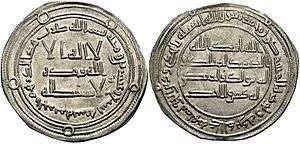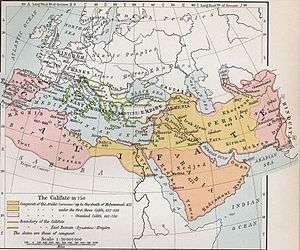Marwan II
Marwan ibn Muhammad ibn Marwan ibn al-Hakam (Arabic: مروان بن محمد بن مروان بن الحكم, romanized: Marwān ibn Muḥammad ibn Marwān ibn al-Ḥakam; 691–6 August 750), also called Marwan II, was the fourteenth and last caliph of the Umayyad Caliphate, ruling from 744 until he was killed in 750. Much of his reign was dominated by the Third Muslim Civil War, and he was the last Umayyad ruler to rule the united Caliphate before the Abbasid Revolution toppled the Umayyad dynasty.
| Marwan ibn Muhammad ibn Marwan مروان بن محمد بن مروان | |||||
|---|---|---|---|---|---|
| Khalīfah Amir al-Mu'minin | |||||
 Dirham of Marwan II | |||||
| Last Caliph of the Umayyad Caliphate | |||||
| Reign | 4 December 744 – 25 January 750 | ||||
| Predecessor | Ibrahim ibn al-Walid | ||||
| Successor | As-Saffah as Abbasid Caliph | ||||
| Born | 691 | ||||
| Died | 6 August 750 (aged 59) | ||||
| Issue | Ubaydallah ibn Marwan, Abdallah ibn Marwan | ||||
| |||||
| House | Marwanid | ||||
| Dynasty | Umayyad | ||||
| Father | Muhammad ibn Marwan | ||||
| Religion | Islam | ||||

Muslim state at the death of Muhammad Expansion under the Rashidun Caliphate Expansion under the Umayyad Caliphate
Family
Marwan ibn Muhammad was a member of the Marwanid household of the Umayyad Caliphate. His mother was a most likely a Kurd who was taken captive by Marwans father, Muhammad ibn Marwan, who was the son of the fourth Umayyad Caliph Marwan I (r. 684–685), by a woman named Zaynab, and hence half-brother to fifth Umayyad Caliph Abd al-Malik ibn Marwan (r. 685–705).[1][2]
Reign
In A.H. 114 (732–733) Caliph Hisham appointed Marwan governor of Armenia and Azerbaijan. In A.H. 117 (735–736) Marwan invaded Georgia, devastated it and then took three fortresses of the Alans and made peace with Tumanshah. In A.H. 121 he launched further raids and obtained tribute. In A.H. 126, on hearing news of the plot to overthrow al-Walid II, Marwan wrote to his relatives from Armenia strongly discouraging this. He urged them to harmoniously preserve the stability and well-being of the Umayyad house.
When Yazid III persisted in overthrowing al-Walid II, Marwan at first opposed him, then rendered allegiance to him. On Yazid's early death, Marwan renewed his ambitions, ignored Yazid's named successor Ibrahim and became caliph. Ibrahim initially hid, then requested Marwan give him assurances of personal safety. This Marwan granted and Ibrahim even accompanied the new caliph to Hisham's residence of Rusafah.
Marwan named his two sons Ubaydillah and Abdullah heirs. He appointed governors and proceeded to assert his authority by force. However, anti-Umayyad feeling was very prevalent, especially in Iran and Iraq. The Abbasids had gained much support. As such, Marwan's reign as caliph was almost entirely devoted to trying to keep the Umayyad empire together.
Marwan took Emesa (Homs) after a bitter ten-month siege. Al-Dahhak ibn Qays al-Shaybani led a Kharijite rebellion. He defeated the Syrian forces and took Kufa. Sulayman ibn Hisham turned against Marwan, but suffered a severe defeat. The Kharijites advanced on Mosul and were defeated. Sulayman joined them. Al-Dahhak's successor al-Khaybari was initially successful in pushing back Marwan's centre and even took the caliph's camp and sat on his carpet. However, he and those with him fell in fighting in the camp. Shayban succeeded him. Marwan pursued him and Sulayman to Mosul and besieged them there for six months. Then, reinforced, the caliph drove them out. Shayban fled to Bahrayn where he was killed; Sulayman sailed to India.
In Khurasan there was internal discord with the Umayyad governor Nasr ibn Sayyar facing opposition from al-Harith and al-Kirmani. They also fought each other. In addition Abbasid envoys arrived. There had long been religious fervour and a kind of messianic expectation of Abbasid ascendency. During Ramadan 747 (May 16–June 14), they unfurled the standards of their revolt. Nasr sent his retainer Yazid against them. Yazid, however, was bested, taken and held captive. He was impressed by the Abbasids and when released told Nasr he wanted to join them, but his obligations to Nasr brought him back.
Fighting continued throughout Khurasan with the Abbasids gaining increasing ascendency. Finally, Nasr fell sick and died at Rayy on November 9, 748 at the age of eighty-five.
Marwan campaign in Egypt in 749 to quell the Bashmuric Revolt and secure his rear, but his campaign was a failure.[3] The Abbasids, meanwhile, achieved success in the Hijaz. Marwan suffered a decisive defeat by Abu al-'Abbas al-Saffah on the banks of the Great Zab called Battle of the Zab. At this battle alone, over 300 members of the Umayyad family died. Marwan fled, leaving Damascus, Jordan and Palestine and reaching Egypt, where he was caught and killed on August 6, 750. His heirs Ubaydallah and Abdallah escaped to modern Eritrea. Ubaydallah died in fighting there.
Marwan's death signalled the end of Umayyad fortunes in the East, and was followed by the mass-killing of Umayyads by the Abbasids. Almost the entire Umayyad dynasty was killed, except for the talented prince Abd ar-Rahman who escaped to Spain and founded an Umayyad dynasty there.
References
- Zetterstéen (1993), p. 408
- Donner (2014), p. 110
- Gabra 2003, p. 116.
Bibliography
- Blankinship, Khalid Yahya, ed. (1989). The History of al-Ṭabarī, Volume XXV: The End of Expansion: The Caliphate of Hishām, A.D. 724–738/A.H. 105–120. SUNY Series in Near Eastern Studies. Albany, New York: State University of New York Press. ISBN 978-0-88706-569-9.
- Gabra, Gawdat (2003). "The Revolts of the Bashmuric Copts in the Eighth and Ninth Centuries". In W. Beltz (ed.). Die koptische Kirche in den ersten drei islamischen Jahrhunderten. Institut für Orientalistik, Martin-Luther-Universität. pp. 111–119.CS1 maint: ref=harv (link)
- Hillenbrand, Carole, ed. (1989). The History of al-Ṭabarī, Volume XXVI: The Waning of the Umayyad Caliphate: Prelude to Revolution, A.D. 738–744/A.H. 121–126. SUNY Series in Near Eastern Studies. Albany, New York: State University of New York Press. ISBN 978-0-88706-810-2.
- Kennedy, Hugh (2004). The Prophet and the Age of the Caliphates: The Islamic Near East from the 6th to the 11th Century (Second ed.). Harlow: Longman. ISBN 978-0-582-40525-7.
- Sir John Glubb, "The Empire of the Arabs", Hodder and Stoughton, London, 1963
- Syed Ameer Ali, "A Short History of the Saracens", Macmillan and co., London, 1912
- Williams, John Alden, ed. (1985). The History of al-Ṭabarī, Volume XXVII: The ʿAbbāsid Revolution, A.D. 743–750/A.H. 126–132. SUNY Series in Near Eastern Studies. Albany, New York: State University of New York Press. ISBN 978-0-87395-884-4.
Marwan II Born: 691 Died: August 6, 750 | ||
| Sunni Islam titles | ||
|---|---|---|
| Preceded by Ibrahim ibn al-Walid |
Last Caliph of the Umayyad Caliphate Caliph of Islam Umayyad Caliph 744 – 6 August 750 |
Succeeded by As-Saffah |
| Regnal titles | ||
| Preceded by Ibrahim ibn al-Walid as Caliph |
Leader of the Umayyad Dynasty 744 – 6 August 750 |
Succeeded by Abd ar-Rahman I as Emir of Córdoba |
